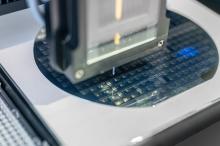
Nanospotters are high-precision devices that are used for droplet coating of surfaces with small volumes of liquids. Although the systems are usually developed for DNA, proteins or other biomolecules, drip coating with other liquids is also possible.
Firstly, the institute has a sciFLEXARRAYER S3 from Scienion, which was designed as a cost-effective entry-level solution for academic institutions and R&D laboratories. It is ideal for the development phase of new applications and impresses with its high flexibility in terms of printable substrates. The Nanospotter uses special pipettes that make it possible to precisely dispense liquid volumes in the nanolitre and picolitre range (30-800 pL per drop) via excitation of piezo crystals. The non-contact dispensing technology creates a homogeneous spot morphology and sensitive surfaces remain undamaged. With up to eight dispensing channels, the system allows flexible parallelisation of the application. The spot positions and patterns can be precisely controlled via the software - parameters such as spot size, spot spacing and the number of spots can be customised. With a resolution of 5 µm and a placement accuracy of less than 15 µm with a repeatability of less than 5 µm, the device fulfils the highest standards of accuracy and reproducibility.
In addition to the Scienion model, the Nano Plotter NP2.1 from GeSiM offers an advanced solution that is suitable for both research and production environments, particularly in the field of in-vitro diagnostics (IVD). The NP2.1 can be configured with 1 to 16 independently controlled piezoelectric pipette tips in any combination, allowing for flexible and application-specific customisation. Particularly noteworthy is the ability to generate more than just rectangular microarrays: the NP2.1 can also draw fine lines on NC membranes, dispense precise volumes into microfluidic cartridges, pipette small volumes into wells or open up new ways of surface functionalisation through targeted drop sequences and real-time mixing. An integrated automatic washing and drying system as well as an optical function test of each pipette tip after sample pick-up ensure process safety and high reliability. Thanks to its ability to bridge the transition from the picolitre to the microlitre range, the NP2.1 can be used for a wide variety of applications - from single-spot analysis to complex high-density arrays with over 3000 spots per square centimetre.
Our devices are fully automated, which ensures high repeatability and efficiency. These features make nanospotters valuable tools in modern bio- and material science, especially for high-throughput screening, the development of microsensors or the precision coating of functional materials.
If you need to use one of the nanospotters, please contact the person responsible for the device.